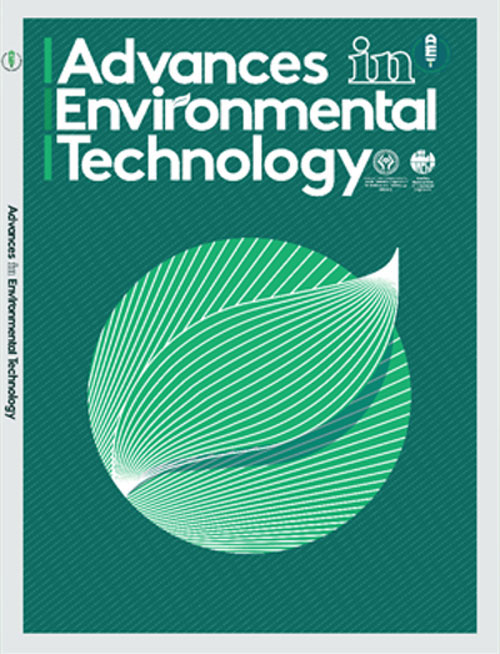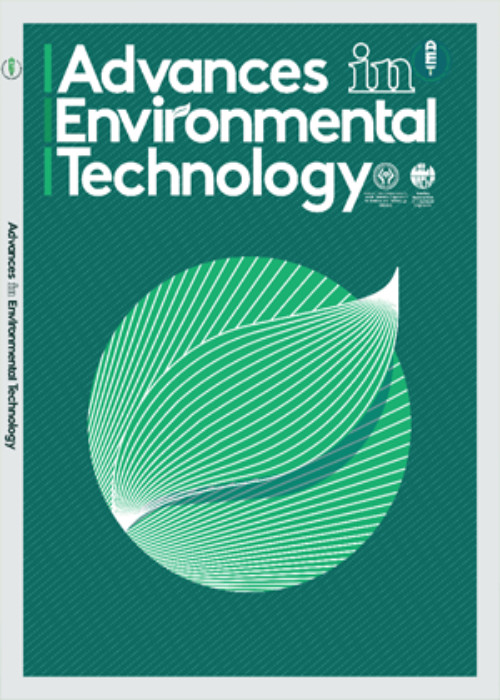فهرست مطالب

Advances in Environmental Technology
Volume:7 Issue: 4, Autumn 2021
- تاریخ انتشار: 1401/01/14
- تعداد عناوین: 6
-
-
Pages 221-229Pendimethalin is a persistent herbicide. It is the third most widely used selective herbicide applied in soil that negatively affects humans and the environment. The current experiment assessed the ability of three bacterial species to degrade this herbicide. Pendimethalin was added to flasks in a 125 mg/L concentration and 107 CFU.mL-1 of Bacillus subtilis, Pseudomonas fluorescens, and Escherichia coli were added separately to the mineral salts medium media (MSM) and stored on a rotary shaker. The bacterial cell number, wet biomass, and chemical oxygen demand (COD) were determined after seven days. The concentration of pendimethalin residue was then determined using high-performance liquid chromatography (HPLC). A completely randomized design (CRD) with three replicates was used to arrange the experimental units, except for HPLC with only one replicate. The experimental results showed that all three bacterial growths rose after seven days post-inoculation in the pendimethalin modified media. A comparison of the growth kinetics of bacteria in the herbicide modified media and the control showed that the bacteria grew faster in the presence of the herbicide. The reduction in the COD parameter occurred in all the tested bacteria, but the highest COD removal efficiency (85%) was observed with B. subtilis. The highest biological degradation of pendimethalin compared to the control occurred in the B. subtilis inoculated media (78%), which also produce the most cell density. Based on the HPLC results, all three bacterial species were capable of biodegrading pendimethalin herbicide, with B. subtilis as the most effective bacterium, followed by E. coli and P. fluorescens.Keywords: Microbial degradation, Chemical oxygen demand (COD), Dinitroaniline herbicides, Pendimethalin, HPLC
-
Pages 231-262
Iran is located in the Earth’s arid zone, and a drought crisis imperils the country as a result of declining water resources. Khuzestan Province, located in the south of Iran, is in critical condition due to water shortages; many of its groves have been destroyed. It also has many respiratory and pulmonary patients due to the constant presence of dust. The pandemic and this dust have caused acute problems for those diagnosed with COVID-19. Due to the importance of water deficit in this province, the present research calculated the Standardized Precipitation Index (SPI) and Standard Precipitation Evaporation Index (SPEI) in a thirty-year statistical period from 1984 to 2014; 12 stations were selected during the months when rainfall was more likely. This study utilized a geostatistical method to prepare zoning maps of SPI and SPEI. Then, various spatial statistics techniques in ArcGIS software were used to identify and locate the exact areas that were the sources of drought with the help of drought hot spots and strong drought clusters. Anselin Local Moran's maps indicated that the high-high precipitation clusters were located in the northeastern regions of Khuzestan. The hot and cold drought spots, which were identified by Getis-Ord G* spatial statistics based on both SPI and SPEI, showed that the hot spots were formed in the southern and southwestern regions; the cold spots were formed in the northwestern regions. Furthermore, the drought hot spots were identified with a 99% confidence level in places where the total ten-year precipitation was less than 270 millimeters.
Keywords: Spatial statistics, Geostatistics, Spatial correlation, Anselin Local Moran index, Hot spots, cold spots -
Pages 263-273Coagulants are used in drinking water treatment plants to increase the size of particles and to help make them bigger and more able to settle at the later stages of the process. Poly-aluminium Chloride (PACL) was used in this study to evaluate its coagulation effectivity in different conditions. Three sets of experiments were done to determine the relationship between some raw water characteristics, including raw turbidity level, pH, and the temperature with optimum doses of PACL, in order to form a mathematical equation that could predict the removal effectivity. The experiments were performed under different seasonal circumstances. Four levels of turbidity were studied, 10, 50, 100, 150 NTU, with six different PACL doses from 5 to 35 mg/L. The results were used to build up a gene expression model (GEP). The GEP model gave very good results with a correlation coefficient equals to (0.91), and a root mean square error of 0.046.Keywords: coagulant, gene expression, Modeling, poly-aluminum chloride, turbidity
-
Pages 275-287In this study, the production of biogas using two fungal strains, Aspergillus niger and Saccharomyces cerevisiae, was studied. In fact, three different waste components consisting of sardine waste (SW), potato peels (PP), and poultry waste (PW) were successfully combined in mesophilic bio-digestion with fungal strains to enhance the production capacities of gas. This work also exhibited the effect of the formulation using a 10-point simplex-centroid mixture design strategy on biogas optimization. The results showed that 12 days was sufficient to achieve stability in mesophilic bio-digestion. This paper proved that the use of fungal inoculum with the mixture of organic and agro-industrial wastes, balanced in chemical elements necessary for cell growth (M7: 66% SW;17% PP;17% PW), led to higher production capacities of biogas. Therefore, the germination and fertilization tests carried out by the digestates resulting from these mixtures showed that they did not inhibit growth and proved to be suitable to improve the crop yields of bell peppers.Keywords: Digestate, Biogas, Organic waste, Aspergillus niger, Saccharomyces cerevisiae
-
Pages 289-304This study evaluated the effects of different operating conditions and the air-to-water ratio (G/L) on the kinetics and the mass transfer coefficient of ammonia (KL) in the air stripping method for removing ammonium ions (NH4+) from wastewater with low concentrations in municipal wastewater treatment plants (WWTPs). The impact of operating conditions including the temperature, initial ammonium ion concentration, pH, and air-to-water ratio (G/L) of <2000:1 (60:1, 70:1, and 80:1) on KL in the air stripping method was investigated using artificial wastewater at laboratory scale. The NH4+ concentrations in the wastewater samples were determined with the Nesslerization method (the standard method for the examination of water and wastewater). According to the results, the minimum (0.0528 h-1) and maximum (0.64825 h-1) of KL were obtained within 1 to 4 h in the operating status that included an initial ammonium ion concentration of 33.63-52.81 mg/l, a temperature of 34-45.7 °C, a pH of 9.48-12.2, and an air-to-water ratio of 60:1-80:1. A comparison of the results of three regression models showed that the air-to-water ratio was the most effective factor on KL. Furthermore, in Model 3 (multivariate linear regression model/comparing four parameters), the effects of the air-to-water ratio, pH, and temperature increased, leading to the acceleration and conversion of ammonium ions (NH4+) to a gaseous form (NH3). Also, the initial NH4+ concentration and pH in Model 4 (multivariate linear regression model by subgroup) at a low (60:1) and high (80:1) G/L ratio were the most influential factors on KL, respectively. The results of this study revealed that the air-to-water ratio (60:1, 70:1, and 80:1) could be used successfully for the elimination of ammonium ions from municipal WWTPs, leading to lower energy costs for the required aeration in the air stripping method.Keywords: Air stripping, Mass transfer coefficient, Ammonia, Air to water ratio, Municipal wastewater treatment plants
-
Pages 305-319The purpose of this study is to compare the environmental risks arising from two models of drilling operations of single-ring and clustered wells in the land area, and finally, to select the most appropriate drilling operations to reduce environmental risks. For this purpose, after identifying the most important drilling activities of oil and gas wells and collecting the opinions of the statistical community, the risks arising from the activities in this field for both drilling models were identified and evaluated using the failure modes and effects analysis (FMEA) method. Then, the best option was selected using the hierarchical analysis process technique, which is useful in prioritizing and selecting the best option. The location of drilling risks in the high and medium risk matrix was determined using the FMEA method for both models with 1<RPN<30. And using the analytic hierarchy process (AHP) technique in the range of zero and one and between the single ring and cluster prioritized the techniques, and the best drilling technique for oil and gas wells, namely cluster drilling, was selected.Keywords: Cluster well drilling, Single ring drilling, Environmental risk, FMEA, AHP


